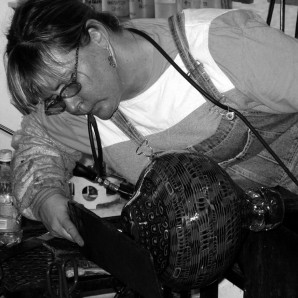
Samphire, Lisa
Lisa Samphire began her glass blowing career in 1985. Since then she has produced a diverse body of work, which includes private and public, sculptural and functional pieces. Lisa has been recognized and applauded for her work, receiving numerous awards scholarships, teaching appointments and commissions. She takes inspiration for her Murrini series from Hundertwasser’s buildings in Vienna and New Zealand. Lisa’s ability to bring a new vitality and approach to her medium year after year is due in part to her ongoing education at The Pilchuk School and The Corning Glass Museum.
Read moreAdding to this is her experience gleaned as owner of Starfish Studio, teacher at Red Deer College and from participation in exhibitions both nationally and internationally. This broad experience had lead to speaking engagements as well as being featured in numerous art publications.
In 2008, Lisa had 4 pieces acquisitioned by the Federal Government of Canada for its Visual Arts Collection. In 2009, Lisa’s work was selected to represent Canada at the Cheongju International Craft Biennale in South Korea.
Reverse Axis or Changed Axis Vessels Technique:
Reverse or changed axis vessels provide a way to use techniques which wrap threads around a piece to provide details which in the final piece run end to end or otherwise offer variations in patterns that would be much more difficult to apply.
The basics of the technique are that a piece is partially blown, shaped and opticked if necessary and then threaded placing many fine lines around the piece in one or more colours. Further work may be done, but the shape is still a roundish bubble. A hole is then made in the side of the piece either by heating a spot with a torch and piercing or by blowing out the hot weakened spot. An alternate spot heating method normally used before torches were common is to get a blazingly hot bit and putting the blob of glass down on the piece, thus heating it very locally and weakening that area so it can be blown out. The bubble or fragments around the hole are knocked off and the piece reheated so the hole can be evened up. Meanwhile, a pipe is prepared by doing a small gather and blowing it out so it is a hollow ring (donut) on the end of the pipe. This is reheated and flared if necessary to match the size of the hole in the piece. The piece is necked and the new pipe stuck up firmly on the hole, more firmly than a punty is normally applied. The first pipe is cracked off and the piece heated, centered, and finished.
PRESS:
2014, June – Focus Magazine Online “Gather, heat, repeat” READ ARTICLE HERE
2012, October – Contemporary Canadian Glass Magazine “Samphire Fusion: A Review” READ ARTICLE HERE
2006, August – Galleries West “Lisa Samphire: Pattern in Light” READ ARTICLE HERE
